
Documentation
EL5101, EL5101-0010, EL5101-0011
Incremental Encoder Interface
4.2
2017-07-31
Version:
Date:


Table of contents
EL5101, EL5101-0010, EL5101-0011 3Version: 4.2
Table of contents
1 Overview Incremental Encoder Interface ................................................................................................5
2 Foreword ....................................................................................................................................................6
2.1 Notes on the documentation........................................................................................................... 6
2.2 Safety instructions .......................................................................................................................... 7
2.3 Documentation issue status............................................................................................................ 8
2.4 Version identification of EtherCAT devices..................................................................................... 8
3 Product overview.....................................................................................................................................13
3.1 Introduction ................................................................................................................................... 13
3.2 Technology ................................................................................................................................... 15
3.3 Technical data .............................................................................................................................. 18
3.4 Start .............................................................................................................................................. 18
4 Basics communication ...........................................................................................................................20
4.1 EtherCAT basics........................................................................................................................... 20
4.2 EtherCAT cabling – wire-bound.................................................................................................... 20
4.3 General notes for setting the watchdog ........................................................................................ 21
4.4 EtherCAT State Machine .............................................................................................................. 23
4.5 CoE Interface................................................................................................................................ 25
4.6 DC settings ................................................................................................................................... 29
5 Mounting and wiring ...............................................................................................................................34
5.1 Installation on mounting rails ........................................................................................................ 34
5.2 Installation instructions for enhanced mechanical load capacity .................................................. 36
5.3 Connection.................................................................................................................................... 37
5.3.1 Connection system...........................................................................................................37
5.3.2 Wiring...............................................................................................................................39
5.3.3 Shielding ..........................................................................................................................40
5.4 Installation positions ..................................................................................................................... 40
5.5 Mounting of Passive Terminals..................................................................................................... 42
5.6 UL notice....................................................................................................................................... 43
5.7 ATEX - Special conditions (extended temperature range) ........................................................... 45
5.8 ATEX Documentation ................................................................................................................... 46
5.9 LEDs and connection.................................................................................................................... 46
5.9.1 EL5101-00x0....................................................................................................................46
5.9.2 EL5101-0011 ...................................................................................................................48
6 Commissioning........................................................................................................................................50
6.1 TwinCAT Quick Start .................................................................................................................... 50
6.1.1 TwinCAT2 .......................................................................................................................52
6.1.2 TwinCAT 3 .......................................................................................................................62
6.2 TwinCAT Development Environment............................................................................................ 74
6.2.1 Installation of the TwinCAT real-time driver .....................................................................74
6.2.2 Notes regarding ESI device description...........................................................................80
6.2.3 TwinCAT ESI Updater......................................................................................................84
6.2.4 Distinction between Online and Offline ............................................................................84
6.2.5 OFFLINE configuration creation ......................................................................................85
6.2.6 ONLINE configuration creation ........................................................................................90
6.2.7 EtherCAT subscriber configuration ..................................................................................98
6.2.8 NC configuration ............................................................................................................108

Table of contents
EL5101, EL5101-0010, EL5101-00114 Version: 4.2
6.3 General Notes - EtherCAT Slave Application ............................................................................. 111
6.4 EL5101-00x0 .............................................................................................................................. 119
6.4.1 Normal operation mode .................................................................................................119
6.4.2 Enhanced operation mode.............................................................................................129
6.5 EL5101-0011 .............................................................................................................................. 157
6.5.1 Principles of the oversampling function .........................................................................157
6.5.2 Process data and configuration .....................................................................................159
6.5.3 Object description and parameterization - enhanced operation mode ..........................162
7 Appendix ................................................................................................................................................176
7.1 EtherCAT AL Status Codes ........................................................................................................ 176
7.2 Firmware compatibility ................................................................................................................ 176
7.3 Firmware Update EL/ES/EM/EPxxxx.......................................................................................... 177
7.4 Restoring the delivery state ........................................................................................................ 187
7.5 Support and Service ................................................................................................................... 188

Overview Incremental Encoder Interface
EL5101, EL5101-0010, EL5101-0011 5Version: 4.2
1 Overview Incremental Encoder Interface
EL5101-0000 [}13] (Incremental Encoder Interface)
EL5101-0010 [}13] (Incremental Encoder Interface, 20 Mio. increments/s)
EL5101-0011 [}14] (Incremental Encoder Interface, with oversampling)

Foreword
EL5101, EL5101-0010, EL5101-00116 Version: 4.2
2 Foreword
2.1 Notes on the documentation
Intended audience
This description is only intended for the use of trained specialists in control and automation engineering who
are familiar with the applicable national standards.
It is essential that the documentation and the following notes and explanations are followed when installing
and commissioning these components.
It is the duty of the technical personnel to use the documentation published at the respective time of each
installation and commissioning.
The responsible staff must ensure that the application or use of the products described satisfy all the
requirements for safety, including all the relevant laws, regulations, guidelines and standards.
Disclaimer
The documentation has been prepared with care. The products described are, however, constantly under
development.
We reserve the right to revise and change the documentation at any time and without prior announcement.
No claims for the modification of products that have already been supplied may be made on the basis of the
data, diagrams and descriptions in this documentation.
Trademarks
Beckhoff
®
, TwinCAT
®
, EtherCAT
®
, Safety over EtherCAT
®
, TwinSAFE
®
, XFC
®
and XTS
®
are registered
trademarks of and licensed by Beckhoff Automation GmbH.
Other designations used in this publication may be trademarks whose use by third parties for their own
purposes could violate the rights of the owners.
Patent Pending
The EtherCAT Technology is covered, including but not limited to the following patent applications and
patents: EP1590927, EP1789857, DE102004044764, DE102007017835 with corresponding applications or
registrations in various other countries.
The TwinCAT Technology is covered, including but not limited to the following patent applications and
patents: EP0851348, US6167425 with corresponding applications or registrations in various other countries.
EtherCAT
®
is registered trademark and patented technology, licensed by Beckhoff Automation GmbH,
Germany
Copyright
© Beckhoff Automation GmbH & Co. KG, Germany.
The reproduction, distribution and utilization of this document as well as the communication of its contents to
others without express authorization are prohibited.
Offenders will be held liable for the payment of damages. All rights reserved in the event of the grant of a
patent, utility model or design.

Foreword
EL5101, EL5101-0010, EL5101-0011 7Version: 4.2
2.2 Safety instructions
Safety regulations
Please note the following safety instructions and explanations!
Product-specific safety instructions can be found on following pages or in the areas mounting, wiring,
commissioning etc.
Exclusion of liability
All the components are supplied in particular hardware and software configurations appropriate for the
application. Modifications to hardware or software configurations other than those described in the
documentation are not permitted, and nullify the liability of Beckhoff Automation GmbH & Co. KG.
Personnel qualification
This description is only intended for trained specialists in control, automation and drive engineering who are
familiar with the applicable national standards.
Description of symbols
In this documentation the following symbols are used with an accompanying safety instruction or note. The
safety instructions must be read carefully and followed without fail!
DANGER
Serious risk of injury!
Failure to follow the safety instructions associated with this symbol directly endangers the
life and health of persons.
WARNING
Risk of injury!
Failure to follow the safety instructions associated with this symbol endangers the life and
health of persons.
CAUTION
Personal injuries!
Failure to follow the safety instructions associated with this symbol can lead to injuries to
persons.
Attention
Damage to the environment or devices
Failure to follow the instructions associated with this symbol can lead to damage to the en-
vironment or equipment.
Note
Tip or pointer
This symbol indicates information that contributes to better understanding.

Foreword
EL5101, EL5101-0010, EL5101-00118 Version: 4.2
2.3 Documentation issue status
Version Comment
4.2 - Update chapter “Technology”
- Update structure
- Update revision status
4.1 - Addenda EL5101-00111
- Update structure
- Update revision status
4.0 - Migration in ST4
- Update structure
- Update revision status
3.7 - Update chapter "Technical data"
- Addenda chapter "Installation instructions for enhanced mechanical load capacity"
- Update structure
- Update revision status
3.6 - Update chapter "Technical data"
- Update structure
- Update revision status
3.5 - Addenda in the chapter "Process data"
3.4 - Addenda in the chapter "Process data"
3.3 - Addenda for EL5101-0010
3.2 - Note on single-ended connection added
3.1 - Note on period/frequency measurement added
3.0 - Object description and further notes added
2.9 - EL5101-0010 added
2.8 - New safety instructions added
2.7 - Technical data added
2.6 - Object description and Technical notes added
2.5 - Note for compatibility added
2.4 - Object description added
2.3 - Division of operating modes
2.2 - Technical data added, object description added
2.1 - Technical data added
2.0 - Technical data added, object description added
1.1.1 - Technical data corrected
1.1 - Correction of the note "Non-Volatile Settings"
1.0 - Extended description for status LEDs added
0.1 - First provisional documentation for EL5101
2.4 Version identification of EtherCAT devices
Designation
A Beckhoff EtherCAT device has a 14-digit designation, made up of
• family key
• type
• version
• revision

Foreword
EL5101, EL5101-0010, EL5101-0011 9Version: 4.2
Example Family Type Version Revision
EL3314-0000-0016 EL terminal
(12 mm, non-
pluggable connection
level)
3314 (4-channel thermocouple
terminal)
0000 (basic type) 0016
ES3602-0010-0017 ES terminal
(12 mm, pluggable
connection level)
3602 (2-channel voltage
measurement)
0010 (high-
precision version)
0017
CU2008-0000-0000 CU device 2008 (8-port fast ethernet switch) 0000 (basic type) 0000
Notes
• The elements mentioned above result in the technical designation. EL3314-0000-0016 is used in the
example below.
• EL3314-0000 is the order identifier, in the case of “-0000” usually abbreviated to EL3314. “-0016” is the
EtherCAT revision.
• The order identifier is made up of
- family key (EL, EP, CU, ES, KL, CX, etc.)
- type (3314)
- version (-0000)
• The revision -0016 shows the technical progress, such as the extension of features with regard to the
EtherCAT communication, and is managed by Beckhoff.
In principle, a device with a higher revision can replace a device with a lower revision, unless specified
otherwise, e.g. in the documentation.
Associated and synonymous with each revision there is usually a description (ESI, EtherCAT Slave
Information) in the form of an XML file, which is available for download from the Beckhoff web site.
From 2014/01 the revision is shown on the outside of the IP20 terminals, see Fig. “EL5021 EL terminal,
standard IP20 IO device with batch number and revision ID (since 2014/01)”.
• The type, version and revision are read as decimal numbers, even if they are technically saved in
hexadecimal.
Identification number
Beckhoff EtherCAT devices from the different lines have different kinds of identification numbers:
Production lot/batch number/serial number/date code/D number
The serial number for Beckhoff IO devices is usually the 8-digit number printed on the device or on a sticker.
The serial number indicates the configuration in delivery state and therefore refers to a whole production
batch, without distinguishing the individual modules of a batch.
Structure of the serial number: KKYYFFHH
KK - week of production (CW, calendar week)
YY - year of production
FF - firmware version
HH - hardware version
Example with
Ser. no.: 12063A02: 12 - production week 12 06 - production year 2006 3A - firmware version 3A 02 -
hardware version 02
Exceptions can occur in the IP67 area, where the following syntax can be used (see respective device
documentation):
Syntax: D ww yy x y z u
D - prefix designation
ww - calendar week
yy - year
x - firmware version of the bus PCB

Foreword
EL5101, EL5101-0010, EL5101-001110 Version: 4.2
y - hardware version of the bus PCB
z - firmware version of the I/O PCB
u - hardware version of the I/O PCB
Example: D.22081501 calendar week 22 of the year 2008 firmware version of bus PCB: 1 hardware version
of bus PCB: 5 firmware version of I/O PCB: 0 (no firmware necessary for this PCB) hardware version of I/O
PCB: 1
Unique serial number/ID, ID number
In addition, in some series each individual module has its own unique serial number.
See also the further documentation in the area
• IP67: EtherCAT Box
• Safety: TwinSafe
• Terminals with factory calibration certificate and other measuring terminals
Examples of markings
Fig.1: EL5021 EL terminal, standard IP20 IO device with batch number and revision ID (since 2014/01)
Fig.2: EK1100 EtherCAT coupler, standard IP20 IO device with batch number

Foreword
EL5101, EL5101-0010, EL5101-0011 11Version: 4.2
Fig.3: CU2016 switch with batch number
Fig.4: EL3202-0020 with batch numbers 26131006 and unique ID-number 204418
Fig.5: EP1258-00001 IP67 EtherCAT Box with batch number 22090101 and unique serial number 158102
Fig.6: EP1908-0002 IP67 EtherCAT Safety Box with batch number 071201FF and unique serial number
00346070

Foreword
EL5101, EL5101-0010, EL5101-001112 Version: 4.2
Fig.7: EL2904 IP20 safety terminal with batch number/date code 50110302 and unique serial number
00331701
Fig.8: ELM3604-0002 terminal with ID number (QR code) 100001051 and unique serial number 44160201

Product overview
EL5101, EL5101-0010, EL5101-0011 13Version: 4.2
3 Product overview
3.1 Introduction
Interface terminal for incremental encoder
EL5101-00x0
Fig.9: EL5101
The EL5101-00x0 EtherCAT Terminal is an interface for direct connection of incremental encoders with
differential inputs (RS422). A 16-bit counter (in normal operating mode) or a switchable 16/32-bit counter (in
enhanced operating mode) with a quadrature decoder and a 16-bit latch (in normal operating mode) or 32-bit
latch (in enhanced operating mode) for the zero pulse can be read, set or enabled. Incremental encoders
with alarm output can be connected at the negative switching status input of the interface. The measurement
of period and frequency is possible. The gate input allows the locking of the counter, alternatively with a high
or low level. The latch input is similarly configurable and evaluates high or low levels. The EL5101-0000 can
also be used as bidirectional counter on channel A; channel B specifies the count direction.
Through the further development of the EL5101-0000 an enhanced operating mode is available (from
firmware 14 / hardware 09 [}176]), which can be parameterized in the TwinCAT System Manager,
depending on the hardware used.
Older EL5101-0000 devices do not support this enhanced operating mode (see Table 1)!
Version from FW/HW ESI Functional description
normal operating mode
EL5101-0000
03/05 from EL5101-0000-0000 All basic functions as described above
enhanced operating mode
EL5101-0000
14/09 from EL5101-0000-1018 Changes to the normal operating mode
- Distributed clock support
- Micro-increments
- Open circuit detection
- Connection of SingleEnded signals possible
Table 1: Operating modes EL5101-0000

Product overview
EL5101, EL5101-0010, EL5101-001114 Version: 4.2
The EL5101-0010 with a resolution of 20 mio. increments/s at 5 MHz and 4-fold evaluation is only applicable
for the enhanced operating mode. The inputs can process differential signals according to RS485. The
microincrement mode is not available for the EL5101-0010.
The EL5101-00x0 supports distributed clocks in the enhanced operating mode, i.e. the input data can be
recorded synchronously with other data that are also linked to Distributed Clock slaves. The accuracy across
the system is < 100 ns.
The documentation is divided in the chapter "Commissioning [}50]" into the handling of the two operating
modes, for which reason the decision must be made during commissioning as to which operating mode is to
be used.
EL5101-0011
Fig.10: EL5101-0011
The EL5101-0011 EtherCAT Terminal is also an interface for the direct connection of incremental encoders
with differential inputs (RS422). A 32-bit counter with quadrature decoder can be read and set. The
EL5101-0011 supports the oversampling principle. Using this method the resolution of the position value can
be increased to n times the bus cycle time. The current counter value is thereby read at several configurable
and equidistant times between two fieldbus communication cycles with an adjustable whole number multiple
(oversampling factor: n) of the bus cycle time. The transfer of a packet of n position values of 32 bits each to
the higher-level controller takes place in the next fieldbus communication cycle. The minimum sampling time
here is 10 µs (100 kSps). Areas of application of the EL5101-0011 lie in particular in the area of high-
resolution position detection.
The EL5101-0011 supports distributed clocks, i.e. the input data can be synchronously acquired with other
data that, similarly distributed, are connected to distributed slave clocks. The system accuracy is around <
100ns.
Quick links
• Basics communication [}20]
• Creation of the TwinCAT configuration [}90]
• EL5101-00x0 – process data, modes, object description [}119]
• EL5101-0011 – process data, modes, object description [}157]
• LEDs and connection [}46]

Product overview
EL5101, EL5101-0010, EL5101-0011 15Version: 4.2
3.2 Technology
The EL5101-00x0 incremental encoder interface terminal enables connection of incremental encoders with
A/B/C track to the Bus Coupler and the PLC. A 16-bit counter (in normal operating mode) or a switchable
16/32-bit counter (in enhanced operating mode) with a quadrature decoder and a 16-bit latch (in normal
operating mode) or 32-bit latch (in enhanced operating mode) can be read, set or enabled. Differential
signals based on RS485 are provided as encoder connection. From hardware09 [}176] single-ended 5 V
signals are possible for the EL5101-0000 based on pull-up resistors.
In addition to the encoder inputs A, B and C, an additional latch input G1 (24 V) and a gate input G2 (24 V)
for locking the counter during operation are available.
The terminal is supplied as a 4-fold quadrature decoder with complementary analysis of the sensor signals
A, B, C. If the incremental encoder has an alarm output it can be connected to the INPUT 1 status input of
the EL5101-00x0. The EL5101-0000 can optionally be operated as a bidirectional counter terminal on
channel A.
Through the further development of the EL5101-0000 an enhanced operating mode is available (from
firmware 14 / hardware 09 [}176]), which can be parameterized in the TwinCAT System Manager,
depending on the hardware used.
Older EL5101-0000 devices do not support this extended operating mode (see Table 1)!
Version from FW/
HW
ESI Functional description
normal operating mode
EL5101-0000
03/05 from
EL5101-0000-0000
All basic functions as described above
enhanced operating
mode
EL5101-0000
14/09 from
EL5101-0000-1018
Changes to the normal operating mode
- Distributed clock support
- Micro-increments
- Broken wire detection
- Connection of SingleEnded signals
possible
Table 1: Operating modes EL5101-0000
The EL5101-0010 with a resolution of 20 mio. increments/s at 5 MHz and 4-fold evaluation is only applicable
for the enhanced operating mode. The inputs can process differential signals according to RS485. The
microincrement mode is not available for the EL5101-0010.
Note
Compatibility in the case of service
An EL5101-0000 designed for and used in enhanced operating mode cannot be replaced
with an EL5101-0000 with older hardware version (< 09)! An EL5101-0010 only supports
the enhanced operating mode and is not exchange-compatible with an EL5101-0000 (hard-
ware version < 09)!
Irrespective of the hardware/firmware version, after integration into a system an EL5101-0000 reports in
normal operating mode.
During commissioning the user has to decide with what functionality, i.e. in what operating mode, the
EL5101-0000 is to be used. This depends on the required functions and, of course, the hardware version.
Hardware older then firmware 14/hardware 09 [}176], for example, will not support enhanced operating
mode functions.
Combination of functions from different operating modes is not possible.
Specific settings are described in the following two sections.

Product overview
EL5101, EL5101-0010, EL5101-001116 Version: 4.2
Note
Process data monitoring
• WcState: if ≠ 0, this EtherCAT device does not take part in the process data traffic
• State: if ≠ 8, the EtherCAT device is not in OP (operational) status
• TxPDO state, SyncError: if ≠ 0, then no valid process data are available, e.g. caused
by broken wire
• TxPDO Toggle: if this bit is toggling, a new set of process data is available
EtherCAT cycle time
For the EL5101 a minimum EtherCAT cycle time of >100 µs is recommended. If a faster cycle time is used,
the toggling process record TxPDO Toggle should be used to monitor when new process data are supplied
by the EL5101.
EL5101 input impedance
The signal source must be able to operate the input impedance of the EL5101 (typically 220Ω, subject to
modification) with adequate voltage levels according to RS485.
Gate/latch input
For gate and latch inputs (24 V) a max. input frequency of 1 MHz is permitted. Subject to modification.
Level on interface
In differential mode the EL5101-00xx expects the signal levels after RS422. The data are transferred without
ground reference as voltage difference between two cables (signal A and inverted signal /A). The terminal
analyses signal levels in the range -200 mV < Vid < +200 mV as valid signals. The differential signal must be
in the common mode range (<+13.2 V and >-10 V, with respect to GND) (cf. diagram). Signal levels outside
this range can lead to destruction.

Product overview
EL5101, EL5101-0010, EL5101-0011 17Version: 4.2
Fig.11: Level interface
In differential mode only the voltage difference is evaluated, so that common-mode interference on the
transmission link does not lead to corruption of the wanted signal, since any interference affects both cables
simultaneously.
If the EL5101 is only operated in single-ended mode, a nominal level voltage between 3.5V and 5.5V is
expected.
The EL5101-0010 and EL5101-0011 do not support single-ended mode.
In the EL5101-0010 and EL5101-0011 versions, open circuit detection (Index 0x80n0:0B, 0x80n0:0C,
0x880n0:0C) is typically activated in the range -0.475V > Vid >+0.475V. For the EL5101, it is typically
activated for the range -1.5V > Vid > +1.5V (subject to change).

Product overview
EL5101, EL5101-0010, EL5101-001118 Version: 4.2
3.3 Technical data
Technical data EL5101-0000 EL5101-0010 EL5101-0011
Sensor connection A, ¬A, B, ¬B, C, ¬C (RS422 dif-
ferential inputs)
from hardware 09 [}176]: also
single-ended connection (5V
±20%) possible
A, ¬A, B, ¬B, C, ¬C (RS422 differential inputs)
Additional inputs gate, latch (24V
DC
, both max. 1 MHz permitted),
status input (max. 5V
DC
, potential-free, switching to negative poten-
tial)
-
Sensor supply 5 V
DC
Sensor output current 0.5A
Counter 16bit, 16/32bit switchable
(from firmware 14 / hardware 09
[}176])
16bit, 16/32bit switchable 32 bit
Zero pulse latch 16bit, 16/32bit switchable
(from firmware 14 / hardware 09
[}176])
16bit, 16/32bit switchable -
Limit frequency 1 MHz
(equals 4million increments with
4-fold evaluation)
5 MHz
(equals 20million increments with 4-fold evaluation)
Quadrature decoder 4-fold evaluation
Distributed Clocks in enhanced operating mode
(from firmware 14 / hardware 09
[}176])
yes
Broken wire detection to sen-
sor
in enhanced operating mode
(from firmware 14 / hardware 09
[}176])
yes
Commands read, set, enable read, set
Oversampling factor - n = 1..100, adjustable
Cycle time min. 100 µs min. 500 µs
Conversion time - 10 µs / 100 kSps
Current consumption via E-
bus
typ. 130 mA
Current consumption from the
power contacts
0.1A (excluding sensor load current)
Electrical isolation 500 V (E-bus/field voltage)
Bit width in process image up to 6bytes outputs, 22bytes inputs, depends on parameterization
Configuration
via TwinCAT System Manager [}98]
Weight approx. 100 g
Permissible ambient tempera-
ture range during operation
-25 °C ... +60 °C (extended temperature range)
Permissible ambient tempera-
ture range during storage
-40 °C ... +85 °C
Permissible relative humidity 95%, no condensation
Dimensions (W x H x D) approx. 27 mm x 100 mm x 70 mm (width aligned: 24 mm)
Mounting [}34]
on 35 mm mounting rail conforms to EN 60715
Vibration/shock resistance conforms to EN 60068-2-6 / EN 60068-2-27,
see also installation instructions [}36] for enhanced mechanical load capacity
EMC immunity/emission conforms to EN 61000-6-2 / EN 61000-6-4
Protection class IP20
Installation position variable
Approval CE
ATEX [}45]
cULus [}43]
3.4 Start
For commissioning:
• mount the EL5101 as described in the chapter Mounting and wiring [}34]

Product overview
EL5101, EL5101-0010, EL5101-0011 19Version: 4.2
• configure the EL5101 in TwinCAT as described in the chapter Commissioning [}50].

Basics communication
EL5101, EL5101-0010, EL5101-001120 Version: 4.2
4 Basics communication
4.1 EtherCAT basics
Please refer to the chapter EtherCAT System Documentation for the EtherCAT fieldbus basics.
4.2 EtherCAT cabling – wire-bound
The cable length between two EtherCAT devices must not exceed 100 m. This results from the FastEthernet
technology, which, above all for reasons of signal attenuation over the length of the cable, allows a maximum
link length of 5 + 90 + 5 m if cables with appropriate properties are used. See also the Design
recommendations for the infrastructure for EtherCAT/Ethernet.
Cables and connectors
For connecting EtherCAT devices only Ethernet connections (cables + plugs) that meet the requirements of
at least category 5 (CAt5) according to EN 50173 or ISO/IEC 11801 should be used. EtherCAT uses 4 wires
for signal transfer.
EtherCAT uses RJ45 plug connectors, for example. The pin assignment is compatible with the Ethernet
standard (ISO/IEC 8802-3).
Pin Color of conductor Signal Description
1 yellow TD + Transmission Data +
2 orange TD - Transmission Data -
3 white RD + Receiver Data +
6 blue RD - Receiver Data -
Due to automatic cable detection (auto-crossing) symmetric (1:1) or cross-over cables can be used between
EtherCAT devices from Beckhoff.
Note
Recommended cables
Suitable cables for the connection of EtherCAT devices can be found on the Beckhoff web-
site!
E-Bus supply
A bus coupler can supply the EL terminals added to it with the E-bus system voltage of 5V; a coupler is
thereby loadable up to 2A as a rule (see details in respective device documentation).
Information on how much current each EL terminal requires from the E-bus supply is available online and in
the catalogue. If the added terminals require more current than the coupler can supply, then power feed
terminals (e.g. EL9410) must be inserted at appropriate places in the terminal strand.
The pre-calculated theoretical maximum E-Bus current is displayed in the TwinCAT System Manager. A
shortfall is marked by a negative total amount and an exclamation mark; a power feed terminal is to be
placed before such a position.
Page is loading ...
Page is loading ...
Page is loading ...
Page is loading ...
Page is loading ...
Page is loading ...
Page is loading ...
Page is loading ...
Page is loading ...
Page is loading ...
Page is loading ...
Page is loading ...
Page is loading ...
Page is loading ...
Page is loading ...
Page is loading ...
Page is loading ...
Page is loading ...
Page is loading ...
Page is loading ...
Page is loading ...
Page is loading ...
Page is loading ...
Page is loading ...
Page is loading ...
Page is loading ...
Page is loading ...
Page is loading ...
Page is loading ...
Page is loading ...
Page is loading ...
Page is loading ...
Page is loading ...
Page is loading ...
Page is loading ...
Page is loading ...
Page is loading ...
Page is loading ...
Page is loading ...
Page is loading ...
Page is loading ...
Page is loading ...
Page is loading ...
Page is loading ...
Page is loading ...
Page is loading ...
Page is loading ...
Page is loading ...
Page is loading ...
Page is loading ...
Page is loading ...
Page is loading ...
Page is loading ...
Page is loading ...
Page is loading ...
Page is loading ...
Page is loading ...
Page is loading ...
Page is loading ...
Page is loading ...
Page is loading ...
Page is loading ...
Page is loading ...
Page is loading ...
Page is loading ...
Page is loading ...
Page is loading ...
Page is loading ...
Page is loading ...
Page is loading ...
Page is loading ...
Page is loading ...
Page is loading ...
Page is loading ...
Page is loading ...
Page is loading ...
Page is loading ...
Page is loading ...
Page is loading ...
Page is loading ...
Page is loading ...
Page is loading ...
Page is loading ...
Page is loading ...
Page is loading ...
Page is loading ...
Page is loading ...
Page is loading ...
Page is loading ...
Page is loading ...
Page is loading ...
Page is loading ...
Page is loading ...
Page is loading ...
Page is loading ...
Page is loading ...
Page is loading ...
Page is loading ...
Page is loading ...
Page is loading ...
Page is loading ...
Page is loading ...
Page is loading ...
Page is loading ...
Page is loading ...
Page is loading ...
Page is loading ...
Page is loading ...
Page is loading ...
Page is loading ...
Page is loading ...
Page is loading ...
Page is loading ...
Page is loading ...
Page is loading ...
Page is loading ...
Page is loading ...
Page is loading ...
Page is loading ...
Page is loading ...
Page is loading ...
Page is loading ...
Page is loading ...
Page is loading ...
Page is loading ...
Page is loading ...
Page is loading ...
Page is loading ...
Page is loading ...
Page is loading ...
Page is loading ...
Page is loading ...
Page is loading ...
Page is loading ...
Page is loading ...
Page is loading ...
Page is loading ...
Page is loading ...
Page is loading ...
Page is loading ...
Page is loading ...
Page is loading ...
Page is loading ...
Page is loading ...
Page is loading ...
Page is loading ...
Page is loading ...
Page is loading ...
Page is loading ...
Page is loading ...
Page is loading ...
Page is loading ...
Page is loading ...
Page is loading ...
Page is loading ...
Page is loading ...
Page is loading ...
Page is loading ...
Page is loading ...
Page is loading ...
Page is loading ...
Page is loading ...
Page is loading ...
Page is loading ...
Page is loading ...
Page is loading ...
Page is loading ...
Page is loading ...
Page is loading ...
Page is loading ...
Page is loading ...
Page is loading ...
Page is loading ...
-
 1
1
-
 2
2
-
 3
3
-
 4
4
-
 5
5
-
 6
6
-
 7
7
-
 8
8
-
 9
9
-
 10
10
-
 11
11
-
 12
12
-
 13
13
-
 14
14
-
 15
15
-
 16
16
-
 17
17
-
 18
18
-
 19
19
-
 20
20
-
 21
21
-
 22
22
-
 23
23
-
 24
24
-
 25
25
-
 26
26
-
 27
27
-
 28
28
-
 29
29
-
 30
30
-
 31
31
-
 32
32
-
 33
33
-
 34
34
-
 35
35
-
 36
36
-
 37
37
-
 38
38
-
 39
39
-
 40
40
-
 41
41
-
 42
42
-
 43
43
-
 44
44
-
 45
45
-
 46
46
-
 47
47
-
 48
48
-
 49
49
-
 50
50
-
 51
51
-
 52
52
-
 53
53
-
 54
54
-
 55
55
-
 56
56
-
 57
57
-
 58
58
-
 59
59
-
 60
60
-
 61
61
-
 62
62
-
 63
63
-
 64
64
-
 65
65
-
 66
66
-
 67
67
-
 68
68
-
 69
69
-
 70
70
-
 71
71
-
 72
72
-
 73
73
-
 74
74
-
 75
75
-
 76
76
-
 77
77
-
 78
78
-
 79
79
-
 80
80
-
 81
81
-
 82
82
-
 83
83
-
 84
84
-
 85
85
-
 86
86
-
 87
87
-
 88
88
-
 89
89
-
 90
90
-
 91
91
-
 92
92
-
 93
93
-
 94
94
-
 95
95
-
 96
96
-
 97
97
-
 98
98
-
 99
99
-
 100
100
-
 101
101
-
 102
102
-
 103
103
-
 104
104
-
 105
105
-
 106
106
-
 107
107
-
 108
108
-
 109
109
-
 110
110
-
 111
111
-
 112
112
-
 113
113
-
 114
114
-
 115
115
-
 116
116
-
 117
117
-
 118
118
-
 119
119
-
 120
120
-
 121
121
-
 122
122
-
 123
123
-
 124
124
-
 125
125
-
 126
126
-
 127
127
-
 128
128
-
 129
129
-
 130
130
-
 131
131
-
 132
132
-
 133
133
-
 134
134
-
 135
135
-
 136
136
-
 137
137
-
 138
138
-
 139
139
-
 140
140
-
 141
141
-
 142
142
-
 143
143
-
 144
144
-
 145
145
-
 146
146
-
 147
147
-
 148
148
-
 149
149
-
 150
150
-
 151
151
-
 152
152
-
 153
153
-
 154
154
-
 155
155
-
 156
156
-
 157
157
-
 158
158
-
 159
159
-
 160
160
-
 161
161
-
 162
162
-
 163
163
-
 164
164
-
 165
165
-
 166
166
-
 167
167
-
 168
168
-
 169
169
-
 170
170
-
 171
171
-
 172
172
-
 173
173
-
 174
174
-
 175
175
-
 176
176
-
 177
177
-
 178
178
-
 179
179
-
 180
180
-
 181
181
-
 182
182
-
 183
183
-
 184
184
-
 185
185
-
 186
186
-
 187
187
-
 188
188
-
 189
189
-
 190
190
-
 191
191
-
 192
192
-
 193
193
Beckhoff EL5101-0011 Documentation
- Type
- Documentation
- This manual is also suitable for
Ask a question and I''ll find the answer in the document
Finding information in a document is now easier with AI
Related papers
-
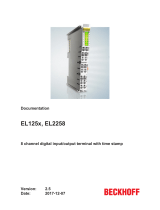 Beckhoff EL2258 Documentation
Beckhoff EL2258 Documentation
-
Beckhoff EtherCAT P Box Quick start guide
-
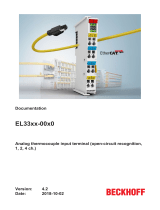 Beckhoff EL3314-0090 Documentation
Beckhoff EL3314-0090 Documentation
-
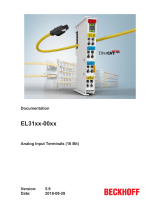 Beckhoff EL3102 Documentation
Beckhoff EL3102 Documentation
-
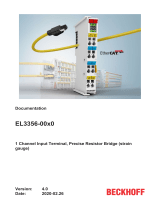 Beckhoff EL3356-0090 Documentation
Beckhoff EL3356-0090 Documentation
-
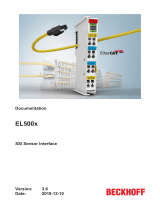 Beckhoff EL5001-0090 Documentation
Beckhoff EL5001-0090 Documentation
-
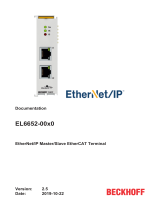 Beckhoff EL6652-00 0 Series Documentation
Beckhoff EL6652-00 0 Series Documentation
-
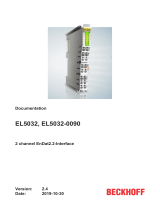 Beckhoff EL5032-0090 Documentation
Beckhoff EL5032-0090 Documentation
-
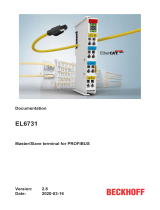 Beckhoff EL6731 Documentation
Beckhoff EL6731 Documentation
-
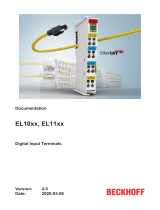 Beckhoff EL11 Series Documentation
Beckhoff EL11 Series Documentation
Other documents
-
Xerox DocuColor 2240 Installation guide
-
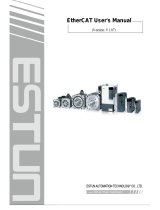 Estun EtherCAT User manual
Estun EtherCAT User manual
-
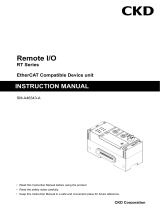 CKD RT Series (EtherCAT) User manual
CKD RT Series (EtherCAT) User manual
-
ABB ESI-S Installation, Operation And Maintanance Manual
-
ABB ESI-S Installation, Operation And Maintenance Instructions
-
ESD CAN-EtherCAT EtherCAT-CAN Gateway Owner's manual
-
WEG SCA06 User guide
-
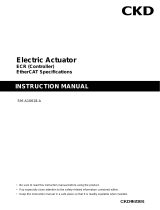 CKD ECR Series EtherCAT User manual
CKD ECR Series EtherCAT User manual
-
Pepperl+Fuchs VBG-EC-K30-DMD-S32-EV Owner's manual
-
Mitsubishi Electric MR-JET-G-N1 User manual












































































































































































































